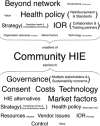Differing Strategies to Meet Information-Sharing Needs: Publicly Supported Community Health Information Exchanges Versus Health Systems' Enterprise Health Information Exchanges
- PMID: 26994710
- PMCID: PMC4941963
- DOI: 10.1111/1468-0009.12180
Differing Strategies to Meet Information-Sharing Needs: Publicly Supported Community Health Information Exchanges Versus Health Systems' Enterprise Health Information Exchanges
Abstract
Policy points: Community health information exchanges have the characteristics of a public good, and they support population health initiatives at the state and national levels. However, current policy equally incentivizes health systems to create their own information exchanges covering more narrowly defined populations. Noninteroperable electronic health records and vendors' expensive custom interfaces are hindering health information exchanges. Moreover, vendors are imposing the costs of interoperability on health systems and community health information exchanges. Health systems are creating networks of targeted physicians and facilities by funding connections to their own enterprise health information exchanges. These private networks may change referral patterns and foster more integration with outpatient providers.
Context: The United States has invested billions of dollars to encourage the adoption of and implement the information technologies necessary for health information exchange (HIE), enabling providers to efficiently and effectively share patient information with other providers. Health care providers now have multiple options for obtaining and sharing patient information. Community HIEs facilitate information sharing for a broad group of providers within a region. Enterprise HIEs are operated by health systems and share information among affiliated hospitals and providers. We sought to identify why hospitals and health systems choose either to participate in community HIEs or to establish enterprise HIEs.
Methods: We conducted semistructured interviews with 40 policymakers, community and enterprise HIE leaders, and health care executives from 19 different organizations. Our qualitative analysis used a general inductive and comparative approach to identify factors influencing participation in, and the success of, each approach to HIE.
Findings: Enterprise HIEs support health systems' strategic goals through the control of an information technology network consisting of desired trading partners. Community HIEs support obtaining patient information from the broadest set of providers, but with more dispersed benefits to all participants, the community, and patients. Although not an either/or decision, community and enterprise HIEs compete for finite organizational resources like time, skilled staff, and money. Both approaches face challenges due to vendor costs and less-than-interoperable technology.
Conclusions: Both community and enterprise HIEs support aggregating clinical data and following patients across settings. Although they can be complementary, community and enterprise HIEs nonetheless compete for providers' attention and organizational resources. Health policymakers might try to encourage the type of widespread information exchange pursued by community HIEs, but the business case for enterprise HIEs clearly is stronger. The sustainability of a community HIE, potentially a public good, may necessitate ongoing public funding and supportive regulation.
Keywords: health information exchange; health information systems; integrated delivery systems; qualitative research.
© 2016 Milbank Memorial Fund.
Figures


References
-
- National Alliance for Health Information Technology . Report to the Office of the National Coordinator for Health Information Technology on defining key health information technology terms. 2008. http://healthit.hhs.gov/portal/server.pt?open=18&objID=848133&parentname.... Accessed March 3, 2010.
-
- Office of the National Coordinator for Health Information Technology . State Health Information Exchange Cooperative Agreement Program. 2012. http://healthit.hhs.gov/portal/server.pt?open=512&objID=1488&mode=2. Accessed October 5, 2015.
-
- Furukawa MF, Patel V, Charles D, Swain M, Mostashari F. Hospital electronic health information exchange grew substantially in 2008–12. Health Aff. 2013;32(8):1346‐1354. - PubMed
-
- Furukawa MF, King J, Patel V, Hsiao C‐J, Adler‐Milstein J, Jha AK. Despite substantial progress in EHR adoption, health information exchange and patient engagement remain low in office settings. Health Aff. 2014;33(9):1672‐1679. - PubMed
-
- US Department of Health & Human Services . 45 CFR Part 170. 2014 Edition Release 2 Electronic Health Record (EHR) Certification Criteria and the ONC HIT Certification Program; Regulatory Flexibilities, Improvements, and Enhanced Health Information Exchange. Final Rule. Federal Register. 2014;79(176). - PubMed
Publication types
MeSH terms
Grants and funding
LinkOut - more resources
Full Text Sources
Other Literature Sources

